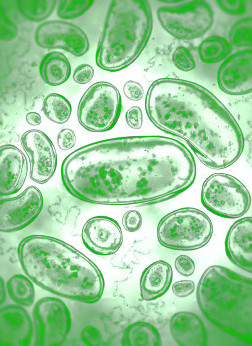Ocean microbe baseline set
 Australian scientists have recorded more than 175,000 tiny ocean microbes to measure the effects of climate change and human activities.
Australian scientists have recorded more than 175,000 tiny ocean microbes to measure the effects of climate change and human activities.
Microbes make up almost 98 per cent of the ocean’s biomass and are responsible for keeping the marine ecosystem healthy.
The new study digs into that vast diversity of microbes and provides new knowledge about their environmental behaviour.
Experts created a big new dataset through an ongoing collaborative initiative involving 18 Australian universities, Commonwealth agencies and research institutes, which recorded more than 175,000 unique species of microbes at seven sites around Australia’s coastline and into the Southern Ocean.
Millions of these tiny organisms are found in every litre of seawater and include cellular life forms such as phytoplankton (algae) and bacteria.
Research leader Dr Mark Brown says ocean microbes are possibly the most important organisms for maintaining a healthy, inhabitable planet.
“Similar to the links between human health and the human microbiome, ocean health is largely controlled by its microbial inhabitants,” he said.
“Forming the foundation of the entire ecosystem, microbes provide food for all other marine life and produce half the oxygen we breathe.
“In this regard, they function in a similar way to organs in a human body. Some microbes act as the lungs of the ocean responsible for gathering and distributing oxygen to the planet, while others act as the gut or liver to detoxify impurities within the water and control the flow of nutrients.”
In a project that started back in 2012, researchers used filtration methods similar to those for purifying drinking water to collect monthly microbe samples at multiple depths from the surface down to 100 metres.
“Different microbes live in different parts of the ocean and they have evolved to occupy every conceivable niche. Different species can be found living on deep-sea hydrothermal vents, in sediments, at varying depths and in warm or cold water,” Dr Brown said.
The material extracted from the filters was genetically sequenced to provide a snapshot of the DNA blueprint of the microbial inhabitants within each sample.
The first data release tracks over 200 million records of more than 175,000 unique species of microbes.
Microbes can be used as a sort of sensor for changes in ocean ecosystems, as they respond rapidly to their environment and a slight change in conditions can dramatically reshape the community structure.
“We found that the microbial assemblages display seasonal cycles, changing with the progression of summer, autumn, winter and spring, returning to the original assemblage again in summer,” Dr Brown explained.
“We have now set baselines for seasonal cycles against which we can identify the impact of climate change,” he added.
The project team is now building models to predict where organisms will live in the future and what functions they will carry out.
“We can now use the baseline data we have collected to make models that tell us how microbes respond to different environmental conditions and how we expect them to change given future climate projections,” said Dr Martin Ostrowski from Macquarie University.
“The primary production and carbon use by marine microbes determines how much food is provided to the rest of the food chain, so our forecasts will be incredibly relevant to scientists but also to industries such as fisheries and tourism.”
The DNA sequence data is available to the public and can be accessed here.







 Print
Print